Rams vs. 49ers: How The Rams Defense Did It
2014 was supposed to be the Year Of The Rams. Sam Bradford was healthy, their offensive line looked better than ever--on paper at least--with high-priced veterans Jake Long and Rodger Saffold playing alongside once-in-a-generation offensive line prospect Greg Robinson.
On defense, Defensive Player of the Year candidate Robert Quinn was just entering the prime of his career, and fellow defensive line starters Chris Long, Michael Brockers and Aaron Donald were all selected in the first round, and are in the primes of their careers.
Then Bradford and both Longs got injured. Robinson wasn't even initially in the starting lineup. And the Rams started 2-4. Their defense, especially their line, who had only one collective sack through the first three games, just couldn't live up to their talent.
But Sunday's game against the 49ers showed why so many (including me) thought they would make the playoffs prior to the season. Their defense kept them in this game, and their offense did just enough to win it.
Their defense wasn't as dominant as the numbers--8 sacks and 10 points allowed--would suggest, but they clearly won the battle at the line of scrimmage by getting pressure on Colin Kaepernick.
The Rams did a lot of blitzing, more than I would have expected with their talented defensive line playing against one of the poorer offensive lines in the NFL this year. But St. Louis seemingly dared Kapernick to make quick decisions and accurate throws under pressure, which he didn't do with any consistency.
In the first half, it seemed to be more of a playcalling problem, which is probably on Kaepernick for not making the right adjustments, but also could be on the coaching staff if they didn't give Kaepernick the freedom to make adjustments in the first place.
Earlier in the game, the Rams blitzes were much more effective from a schematic standpoint. The Rams showed blitz here, with all of their defenders up near the line of scrimmage and no deep safeties:
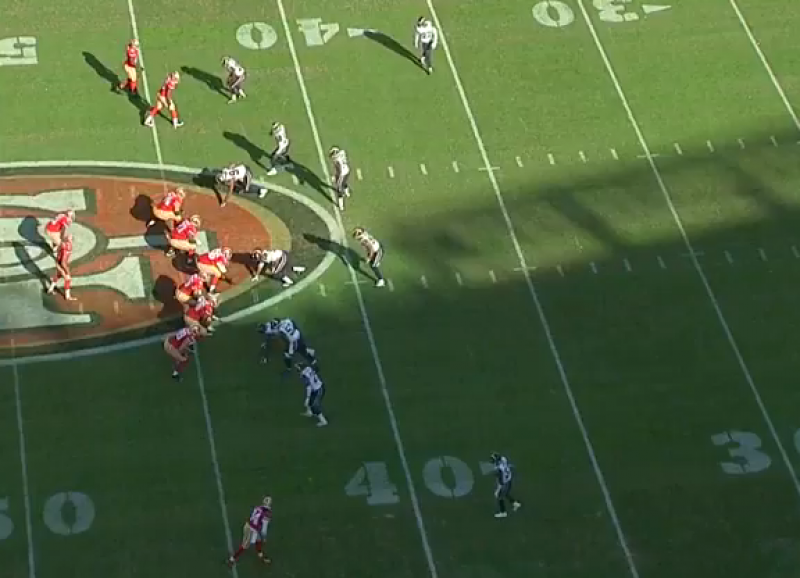
The Rams brought six here, and the 49ers don't have a "hot" recevier Kaepernick can go to. This screen shot was taken at the top of Kaepernick's drop, and the receivers all have their backs turned to the line of scrimmage and are running downfield routes:
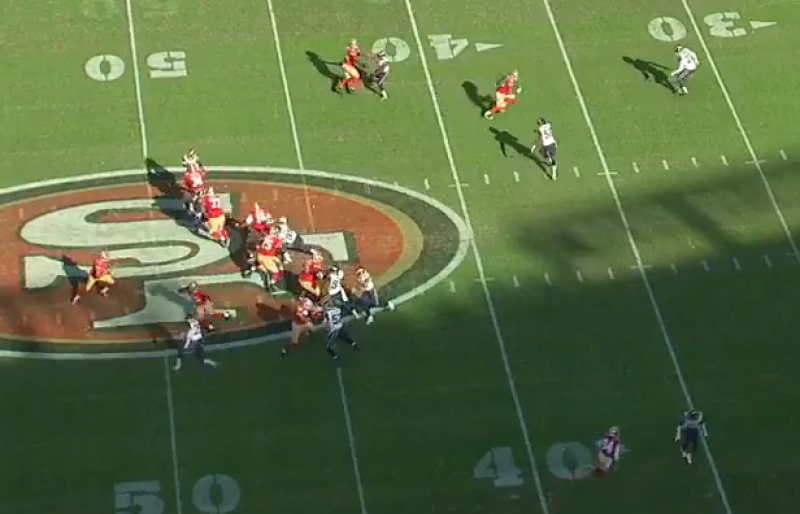
There were also a couple cases throughout the game where Kaepernick simply wasn't seeing the field when under pressure. This is a 3rd-and-10. The Rams blitz, and the 49ers get an open receiver in the flat at the bottom of the screen. He's the "hot" receiver Kaepernick should be throwing to in this case, but for whatever reason Kaepernick doesn't see him. If he gets the receiver the ball quickly, the receiver has some room to work plus a blocker out in front, and this play has a shot at a first down. Instead, Kaepernick failed to get rid of the ball, and got sacked.
If the 49ers were unprepared for Rams blitzes even when they were blatantly obvious pre-snap like in the example above, disguised Rams pressure was even more problematic for SF. In the following example, they only show their blitz at the last possible second before the snap, and Kaepernick doesn't expect it--he rushed the throw into coverage, and he's lucky it wasn't intercepted.
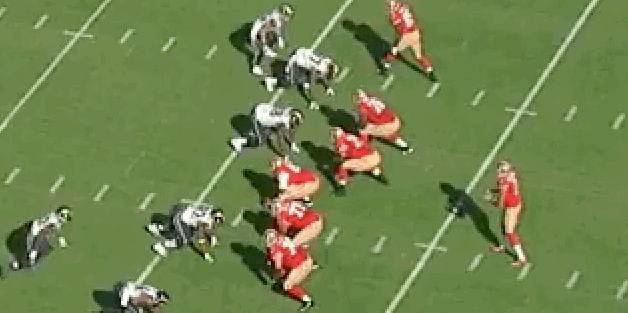
San Francisco looked incredibly unprepared for blitzes during the first half, but, to their credit, they made adjustments at halftime and implemented more hot routes.
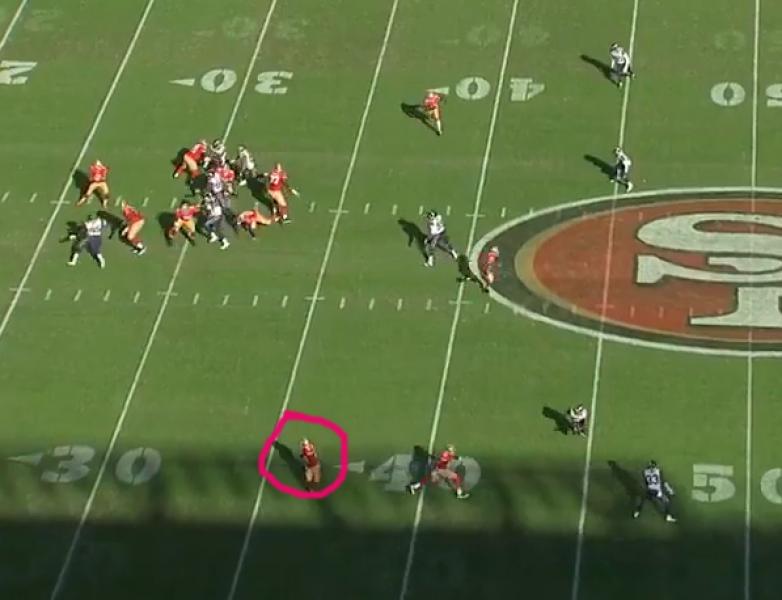
In the second half, SF made better adjustments to the Rams pressure. But for the most part, the offense failed to execute. The 49ers ran more out-breaking routes as opposed to in-breaking routes against the blitz, which were open since the Rams corners largely were playing with inside leverage. But as AJ Green understands, running good routes is one thing, but the quarterback getting the receiver the ball accurately and on time is something entirely different.
Here's another potential touchdown that Kaepernick flat-out didn't see. He had Vernon Davis wide-freaking-open running to space, and instead chose to throw to Michael Crabtree underneath.
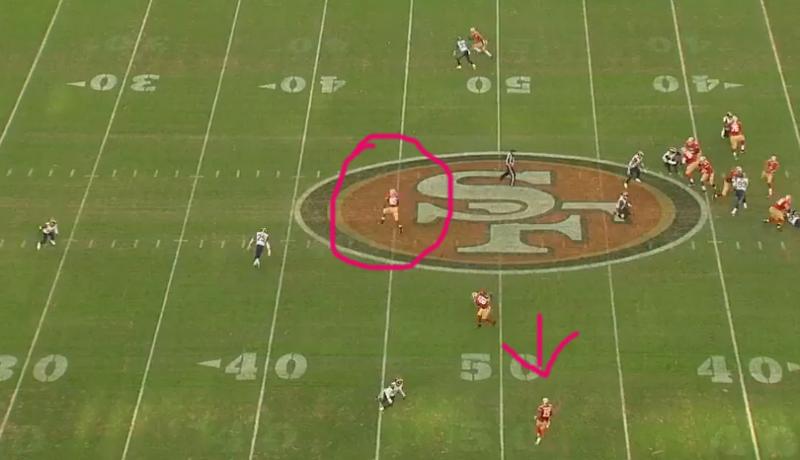
The Rams certainly didn't make many of the throws easy, and EJ Gaines and Trumaine Johnson played very good games in coverage. But still, many of the throws were there, and Kaepernick just missed them. Take this for example:
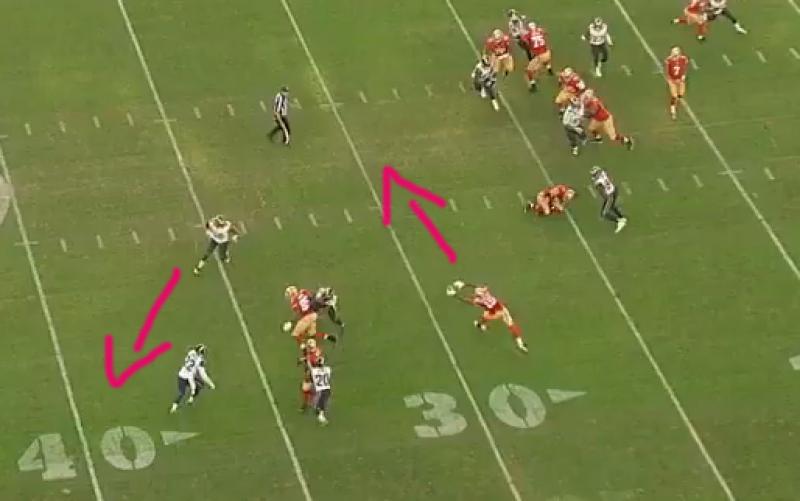
Down 13-10 with under five minutes left, the 49ers faced a 3rd-and-4. The Rams blitzed five rushers and got a free rusher on Kaepernick while playing man coverage across the board. San Francisco was perfectly prepared for this, and ran two receivers upfield to pick the defensive back covering Michael Crabtree and clear room for him to get the ball quickly underneath. This design was extremely effective, as shown. If Crabtree catches this pass and runs to the open space where he's headed, this play may have been a touchdown, or at least a huge gain, since the closest defender to Crabtree is a linebacker who is running in the completely opposite direction. But Kaepernick missed this throw wide, and it fell incomplete.
I've highlighted the pressure St. Louis got on Kaepernick, but the Rams played pretty well coverage-wise too. Their linebackers especially were great in their zone coverage drops, and showed a high field awareness.
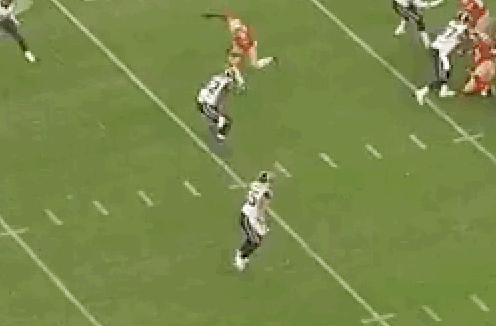
Check out how Alec Ogletree (52) passes of Stevie Johnson to James Laurinaitis, who smoothly transitions to running with Johnson down the field. This is perfect zone coverage, and an excellent job of not letting receivers run free at the second level.
The Rams played mostly zone coverage, with a lot of cover-3, keeping everything in front of them. This was expected, since playing man coverage against a quarterback like Colin Kaepernick is basically asking for him to run all over the place. The Rams did a very good job of containing Kaepernick on the ground:
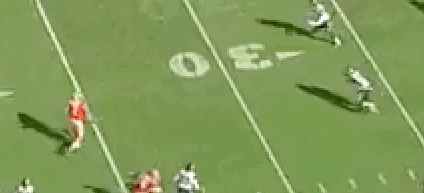
Their zone defense and the athleticism of their linebackers and safeties were key in making sure Kaepernick didn't break off any big gains.
Cover-3 puts a lot of stress on the corners outside, since they're basically playing man coverage. As I touched on, rookie cornerback EJ Gaines had a really good game, and rarely had a pass thrown his way. When he did get an opportunity, he capitalized. This was on the 49ers final drive, and the 49ers targeted Stevie Johnson, who Gaines had one-on-one.
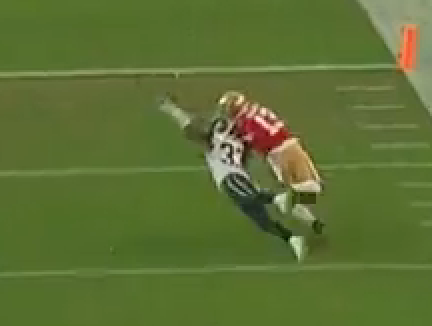
Gaines made a great play on the ball here and broke up the pass. He's only a rookie, but he sure looks like the real deal.
The Rams defense as a whole is obviously very athletic and talented, especially the defensive line. They basically had their way with the 49ers offensive line, and guys like Eugene Sims simply were too athletic. Watch Sims disengage from his block here and make the tackle on Kaepernick when he tries to run. Awesome stuff, and not many defensive linemen could do this.
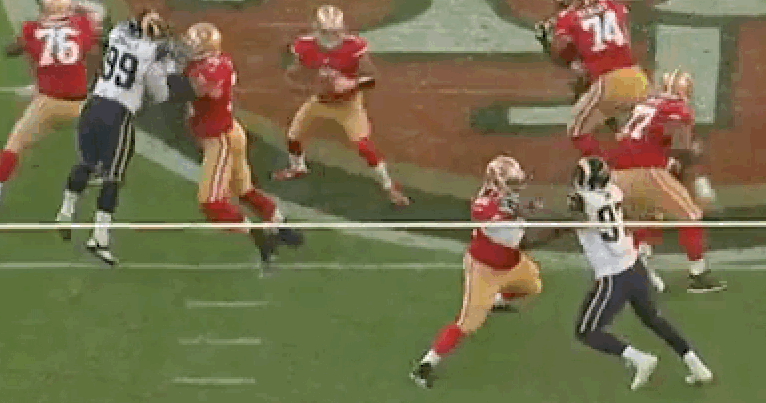
I mentioned the Rams dominance of the 49ers up front, and part of that was due to rookie center Marcus Martin (66) getting his first start and not having his best game.
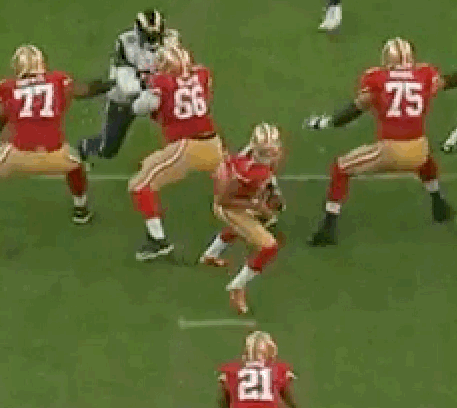
Michael Brockers (90) had his way with Martin for the most part, and gets a nice sack of Kaepernick here. Brockers had a really good game, probably one of the best of his career so far, and was dominant in the running game as well.
When they did blitz, they brought five or six rushers, but used stunts like this to create open lanes to get pressure:
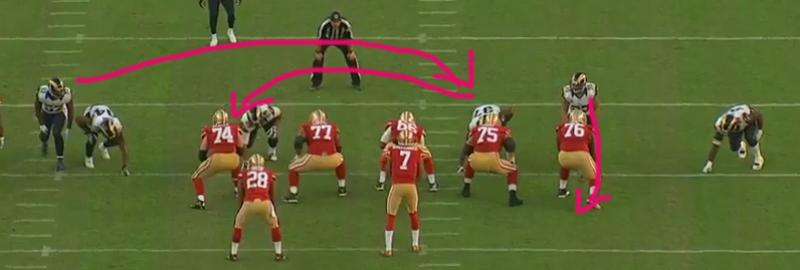
Running back Carlos Hyde correctly jumped to the offensive right to pick up the blitzing Laurinaitis (55), since the 49ers slid the protection left and therefore have an initial 3-to-2 disadvantage on the right side. However, this blitz is designed to create confusion among the offensive line while still covering all the gaps so Kaepernick doesn't escape. D-lineman Eugene Sims (97) stunts to the inside post-snap, occupying Alex Boone (75) and getting in the way so Martin (66) can't slide over and pick up Ogletree (52), who loops around to the middle on his own stunt. By initially occupying Boone, Sims gets just enough of the guard to give Ogletree the room his needs to through as a free rusher to Kaepernick. This play doesn't end up in a sack in this case, but it is still a cool design.
The Rams played a hell of a game on the defensive side of the ball, but they weren't perfect. Kaepernick missed some open throws that could have been big gains, but at this point, that just may be who he is.
One may think that, with the Rams strong defensive line, they shouldn't have to blitz as much to create pressure. But blitzing Kaepernick might be the best way to beat him, no matter your personnel. Blitzing creates confusion and urgency for an offense, and unless the quarterback is completely sure of what he's doing, the play will end up poorly for the offense more often than not.
Credit the Rams for devising this game plan and sticking to it. This was a pretty well-coached performance for them on the defensive side of the ball at least, and provides some hope that they may not finish last in the NFC West this year.



